
The 407 was the first Bristol model to be produced after the car division cut the umbilical cord from their parent company, the Bristol Aeroplane Company, becoming a private and autonomous concern
Bearing a strong resemblance to the 406, the most significant difference between the two models was that the 407 came fitted with a 5.1-litre engine, meaning it was capable of generating a top speed of 125 mph (200 kph) making it the fastest Bristol to date, and by a long way.
T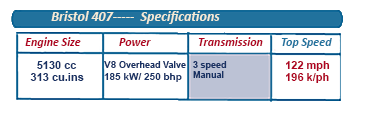 he Bristol 407 was first shown at the 1961 London Motor Show to considerable fanfare from the UK motoring press with one of them going as far as describing Bristol's first model of the Sixties as ‘one of the world's great cars.'
he Bristol 407 was first shown at the 1961 London Motor Show to considerable fanfare from the UK motoring press with one of them going as far as describing Bristol's first model of the Sixties as ‘one of the world's great cars.'
The high production values Bristol set itself — and its customers expected — were not only maintained but the 407 was favourably compared with the best that Aston Martin, Jaguar, and Jensen were producing in the early Sixties as well as the finest of Italian exotica.
B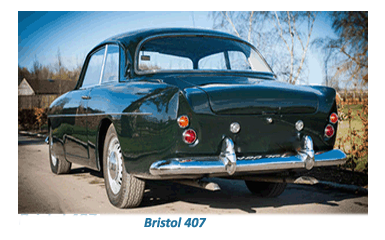 ristol fitted the 407 for the first time with a Chrysler engine, although they had reportedly been considering the possibility of installing a 'Firepower' unit into a 405 in the mid-Fifties.
ristol fitted the 407 for the first time with a Chrysler engine, although they had reportedly been considering the possibility of installing a 'Firepower' unit into a 405 in the mid-Fifties.
For a variety of reasons, a line had been drawn under the further development of a proposed 3.6-litre engine, codenamed Type 160 in 1958, and new development of the 2-litre for road use had peaked with the Type 110 fitted in the 406.
Chrysler's development and release of their small-block V8 with a compatible automatic gearbox could not have been timed better.
![]()
Not only did the compact Canadian Chrysler 5130cc `A' series deliver its power smoothly, but the 'A' series engine's characteristics were perfectly matched to the use of the Torqueflite three-speed automatic transmission
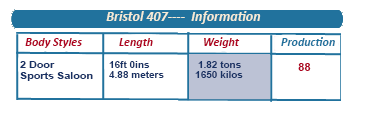 Chrysler's Torqueflite, first introduced in the USA in 1956, had quickly gained a reputation for being one of the best automatic gearboxes in the business. When fitted to the 407, it provided 'effortlessly lively top-gear performance.'
Chrysler's Torqueflite, first introduced in the USA in 1956, had quickly gained a reputation for being one of the best automatic gearboxes in the business. When fitted to the 407, it provided 'effortlessly lively top-gear performance.'
To accommodate the bulk and weight of the new engine and transmission, it was necessary for Bristol to make specific detail changes to the chassis.
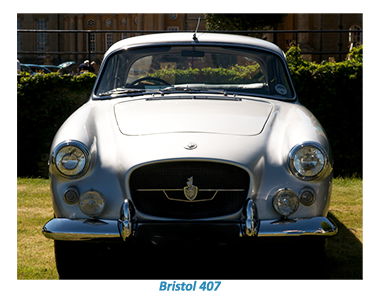 The frame consisted of two box-section side members braced by three cross members, on to which the reshaped floor panels were welded.
The frame consisted of two box-section side members braced by three cross members, on to which the reshaped floor panels were welded.
The boot framework integrated with the rear frame, the same as on the 406. Changes for the 407's chassis came at the front end, where a new box-section cross member supported the wishbone and coil spring assemblies of the front suspension.
The less cumbersome design was also able to support the front of the engine.The 407 chassis, with the fuel tank supported at the rear, and wishbones and coil springs at the front backed up by a new box-section cross member.
The cam and peg steering was less precise than the rack and pinion set-up used on previous models.
Slipping the under the 407's bonnet increased its engine capacity over the 406 by 130 per cent for a weight increase of only 20 per cent.
![]()
Once again the 407 was based on the classic British two-door sports saloon bodywork, this time produced for Bristol by Park Royal Vehicles Ltd, with an aluminium body over a steel frame.
At the front, the more substantial air intake featured a more Pegasus emblem. Lighting consisted of Lucas sealed headlamps with sidelights and direction indicators below the complementary fog and spot lamps flanked the massive chrome bumper with stout riders added to the front-end.
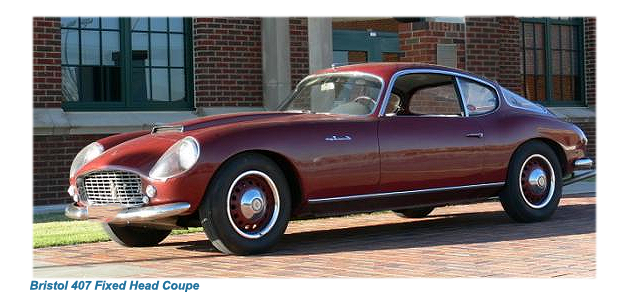 At the rear, taillights and indicators were separate, reversing lights, according to the UK motoring press 'powerful and very efficient.
At the rear, taillights and indicators were separate, reversing lights, according to the UK motoring press 'powerful and very efficient.
The space saved from having to fit in a cumbersome spare wheel meant that the 407’s illuminated boot was large enough to swallow the luggage of all the car's driver and a maximum of three passengers.
The 407 was the recipient of the highest praise from the motoring press, because of the quality and integrity with which it had been built.
With the success of the 407, Bristol had walked away from the threat of closure, in the process creating a well-balanced performance car, offering fast, safe transport for the Sixties.






